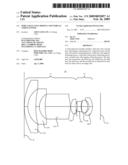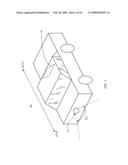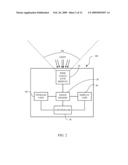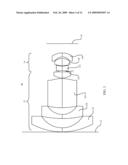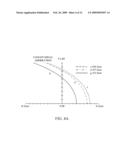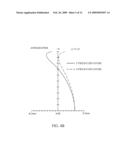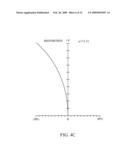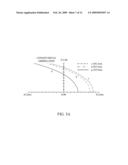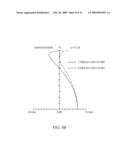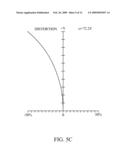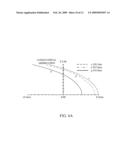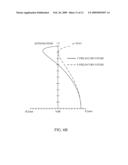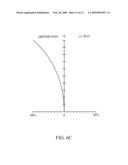Patent application title: WIDE ANGLE LENS MODULE AND VEHICLE VISION SYSTEM
Inventors:
Chun-Ling Lin (Tu-Cheng, TW)
Assignees:
HON HAI PRECISION INDUSTRY CO., LTD.
IPC8 Class: AG02B1304FI
USPC Class:
359751
Class name: Lens reverse telephoto with seven components
Publication date: 2009-02-26
Patent application number: 20090052057
includes a first lens and a second lens with
negative refracting power, a third lens and a fourth lens with positive
refracting power, a fifth lens with negative refracting power, a sixth
lens with positive refracting power, and a seventh lens with negative
refracting power. The first lens, the second lens, the third lens, the
fourth lens, the fifth lens, the sixth lens, and the seventh lens are
disposed in order from an object side to an image side.Claims:
1. A wide angle lens module comprising:a first lens group with positive
refracting power; anda second lens group with positive refracting power,
the first lens group and the second lens group being disposed in order
from an object side to an image side, the first lens group and the second
lens group satisfying the following conditions: 0.8<f12/f<1.2 (1),
5<f14/f<25 (2), wherein f12 is an effective focal length of the
first lens group, f14 is an effective focal length of the second lens
group, and f is a focal length of the wide angle lens module.
2. The wide angle lens module as described in claim 1, wherein the first lens group comprises:a first lens with negative refracting power;a second lens with negative refracting power;a third lens with positive refracting power, the first lens and the third lens satisfying the following conditions: -5.5<f1/f<-4.5 (3), 3.3<f3/f<3.6 (4), v3<35 (5), wherein f1 is a focal length of the first lens, f3 is a focal length of the third lens, v3 is an Abbe number of the third lens; anda fourth lens with positive refracting power.
3. The wide angle lens module as described in claim 2, wherein the first lens is a meniscus lens having a convex surface facing toward the object side.
4. The wide angle lens module as described in claim 2, wherein the second lens is disposed between the first lens and the third lens, the second lens is a meniscus lens having a convex surface facing toward the object side.
5. The wide angle lens module as described in claim 2, wherein the third lens and the fourth lens are bi-convex lenses.
6. The wide angle lens module as described in claim 1, wherein the second lens group comprises:a fifth lens with positive refracting power;a sixth lens with positive refracting power, the sixth lens satisfying the following condition: 1<f6/f<1.2 (6), wherein f6 is a focal length of the sixth lens; anda seventh lens with negative refracting power.
7. The wide angle lens module as described in claim 6, wherein the fifth lens and the sixth lens are bi-convex lenses, the sixth lens is disposed between the fifth lens and the seventh lens.
8. The wide angle lens module as described in claim 6, wherein the seventh lens is a meniscus lens having a convex surface facing toward the image side.
9. The wide angle lens module as described in claim 1, wherein the wide angle lens module further satisfies the following condition: 0.1<f/TTL<0.13, wherein TTL is an overall length of the wide angle lens module.
10. The wide angle lens module as described in claim 1, wherein the wide angle lens module further satisfies the following condition: 2.omega.>140.degree., wherein ω is a half field angle of the wide angle lens module.
11. The wide angle lens module as described in claim 1, wherein the wide angle lens module further comprises:an aperture stop, the aperture stop is disposed between the first lens group and the second lens group.
12. A vehicle vision system configured for capturing images around a vehicle, the vehicle vision system comprising:a wide angle lens module mounted to a portion of the vehicle for receiving light beams originated from objects around the vehicle, the wide angle lens module comprising:a first lens group with positive refracting power; anda second lens group with positive refracting power, the first lens group and the second lens group being disposed in order from an object side to an image side, the first lens group and the second lens group satisfying the following conditions: 0.8<f12/f<1.2 (1), 5<f14/f<25 (2), wherein f12 is an effective focal length of the first lens group, f14 is an effective focal length of the second lens group, and f is a focal length of the wide angle lens module;an image sensor for receiving light beams transmitted from the wide angle lens module and generating digital images;a display unit for displaying the digital images.
13. The vehicle vision system as described in claim 12, wherein the first lens group comprises:a first lens with negative refracting power;a second lens with negative refracting power;a third lens with positive refracting power, the first lens and the third lens satisfying the following conditions: -5.5<f1/f<-4.5 (3), 3.3<f3/f<3.6 (4), v3<35 (5), wherein f1 is a focal length of the first lens, f3 is a focal length of the third lens, v3 is an Abbe number of the third lens; anda fourth lens with positive refracting power.
14. The vehicle vision system as described in claim 12, wherein the second lens group comprises:a fifth lens with positive refracting power;a sixth lens with positive refracting power, the sixth lens satisfying the following condition: 1<f6/f<1.2 (6), wherein f6 is a focal length of the sixth lens; anda seventh lens with negative refracting power.
15. The vehicle vision system as described in claim 12, wherein the wide angle lens module further satisfies the following condition: 0.1<f/TTL<0.13 (7), wherein TTL is an overall length of the wide angle lens module.
16. The vehicle vision system as described in claim 12, wherein the wide angle lens module further satisfies the following condition: 2.omega.>140.degree. (8), wherein ω is a half field angle of the wide angle lens module.
17. A wide angle lens module comprising:a first lens with negative refracting power;a second lens with negative refracting power;a third lens with positive refracting power;a fourth lens with positive refracting power;a fifth lens with negative refracting power;a sixth lens with positive refracting power; anda seventh lens with negative refracting power, the first lens, the second lens, the third lens, the fourth lens, the fifth lens, the sixth lens, and the seventh lens being disposed in order from an object side to an image side of the wide angle lens module.
18. The wide angle lens module as described in claim 17, wherein the wide angle lens module satisfies the following conditions: -5.5<f1/f<-4.5 (1), 3.3<f3/f<3.6 (2), 1<f6/f<1.2 (3), v3<35 (4), wherein f1 is a focal length of the first lens, f3 is a focal length of the third lens, f6 is a focal length of the sixth lens, and v3 is an Abbe number of the third lens.
19. The wide angle lens module as described in claim 17, wherein the wide angle lens module further satisfies the following condition: 1<f/TTL<0.13 (5), wherein TTL is an overall length of the wide angle lens module.
20. The wide angle lens module as described in claim 17, wherein the wide angle lens module further satisfies the following condition: 2.omega.>140.degree. (6), wherein w is a half field angle of the wide angle lens module.Description:
BACKGROUND
[0001]1. Field of the Invention
[0002]The present invention generally relates to, lens modules and vehicles, and more particularly, relates to a wide angle lens module and a vehicle vision system of a vehicle having the wide angle lens module.
[0003]2. Description of Related Art
[0004]It is known that vehicles such as cars and trucks have blind spots when an operator uses reflecting mirrors. Therefore, a camera-based rear view vision system has been proposed to eliminate the blind spots.
[0005]Typically, the camera-based rear view vision system includes a camera located on the rear of the vehicle. However, viewing angles of the typical camera used in the vision systems are narrow and may still leave blind spots.
[0006]Therefore, what is desired is to provide a camera with a wide angle lens module and a vehicle vision system of a vehicle having the wide angle lens module for providing viewing angles that eliminate blind spots around the vehicle.
SUMMARY
[0007]Accordingly, a wide angle lens module is provided. The wide angle lens module includes a first lens group with positive refracting power and a second lens group with positive refracting power. The first lens group and the second lens group are disposed in order from an object side to an image side. The first lens group and the second lens group satisfy the following conditions: 0.8<f12/f<1.2 (1), 5<f14/f<25 (2), wherein f12 is an effective focal length of the first lens group, f14 is an effective focal length of the second lens group, f is a focal length of the wide angle lens module.
[0008]Other advantages and novel features of the present invention will become more apparent from the following detailed description of preferred embodiment when taken in conjunction with the accompanying drawings.
BRIEF DESCRIPTION OF THE DRAWINGS
[0009]FIG. 1 is a vehicle having a wide angle lens module according to an exemplary embodiment.
[0010]FIG. 2 is a block diagram of the vehicle as illustrated in FIG. 1.
[0011]FIG. 3 is a block diagram of the wide angle lens module as illustrated in FIG. 1.
[0012]FIGS. 4A-4C respectively illustrate longitudinal spherical aberration, astigmatism, and distortion of a first exemplary embodiment.
[0013]FIGS. 5A-5C respectively illustrate longitudinal spherical aberration, astigmatism, and distortion of a second exemplary embodiment.
[0014]FIGS. 6A-6C respectively illustrate longitudinal spherical aberration, astigmatism, and distortion of a third exemplary embodiment.
DETAILED DESCRIPTION
[0015]Referring to FIGS. 1 and 2, a wide angle lens module 10 may be rigidly mounted to a rear panel of a vehicle 100 and directed substantially rearward of the vehicle 100. The vehicle 100 includes an image sensor 20 such as a charge coupled device (CCD), a controller 30, a display unit 40 such as a liquid crystal display (LCD), and a storage unit 50 such as a hard disk drive (HDD).
[0016]The wide angle lens module 10 is used for receiving light beams emitted by or reflected from outside objects existing in a wide viewing angle that can be greater than 140°. The light beams received by the wide angle lens module 10 are directed to the image sensor 20. The image sensor 20 converts the light beams received from the wide angle lens module 10 to electrical signals, which are digitized to form digital images. The digital images are displayed on the display unit 40. The digital images may also be encoded to image files, which are stored in the storage unit 50. The controller 30 is a processing unit for controlling various operations of the vehicle 100.
[0017]Referring to FIG. 3, the wide angle lens module 10 includes a first lens group 12 and a second lens group 14. The first lens group 12 and the second lens group 14 are disposed in an order from an object side 16 to an image side 18. The wide angle lens module 10 is designed to be a fixed-focal type wide angle lens module, such that a distance between the first lens group 12 and the second lens group 14 is not adjustable.
[0018]The first lens group 12 has positive refracting power for effectively receiving incident light beams at wide angles. Preferably, the first lens group 12 satisfies the following condition: 0.8<f12/f<1.2 (1), wherein f is a system focal length of the wide angle lens module 10, and f12 is an effective focal length of the first lens group 12. The condition (1) is for configuring the wide angle lens module 10 to correct spherical aberrations. If the ratio f12/f is below the lower limit 0.8, astigmatism becomes great and high-order spherical aberrations are difficult to correct. If the ratio f12/f is above the upper limit 1.2, the wide angle lens module 10 will not be compact.
[0019]The second lens group 14 also has positive refracting power for converging light beams transmitted from the first lens group 12 to the image sensor 20. Preferably, the second lens group 14 satisfies the following condition: 5<f14/f<25 (2), wherein f14 is an effective focal length of the second lens group 14. The condition (2) is for designing the wide angle lens module 10 to be similar to a telecentric optical system, such that the light beams transmitted from the first lens group 12 may be more effectively converged to the image sensor 20. If the ratio f14/f is below the lower limit 5, coma aberrations become great and lateral chromatic aberration is difficult to correct. If the ratio f14/f is above the upper limit 25, distortion becomes so great that it may be difficult to correct. The condition (2) is also used for limiting the second lens group 14 having relatively stronger refracting power in order to make an overall length of the wide angle lens module 10 to be shorter.
[0020]The first lens group 12 includes a first lens 122, a second lens 124, a third lens 126, and a fourth lens 128 that are disposed in that order from the object side 16 to the image side 18. The first lens 122 and the second lens 124 are both meniscus lenses having negative refractive powers. Convex surfaces of the first lens 122 and the second lens 124 face toward the object side 16. The third lens 126 and the fourth lens 128 are both bi-convex lenses having positive refractive powers.
[0021]The second lens group 14 includes a fifth lens 144, a sixth lens 146, and a seventh lens 148. The fifth lens 144 is a bi-concave lens having negative refracting power. The sixth lens 146 is a bi-convex lens having positive refracting power. The seventh lens 148 is a meniscus lens having negative refracting power. A convex surface of the seventh lens 148 faces toward the image side 18.
[0022]The first lens 122 satisfies the following condition: -5.5<f1/f<-4.5 (3), wherein f1 is a focal length of the first lens 122. The condition (3) is for configuring the first lens 122 to receive light beams incident at wide angles. If the ratio f1/f is below the lower limit -5.5, the wide angle lens module 10 will not be compact. If the ratio f1/f is above the upper limit -4.5, it will be difficult to manufacture the first lens 122, particularly when the material is glass, because the first lens 122 has a relatively small radius of curvature in this condition.
[0023]The third lens 126 satisfies the following conditions: v3<35 (4) and 3.3<f3/f<3.6 (5), wherein v3 is an Abbe number of the third lens 126 at d-line, and f3 is a focal length of the third lens 126. The condition (4) is for configuring the wide angle lens module 10 to correct system chromatic aberration. The condition (5) is for configuring the wide angle lens module 10 to correct distortion. If the ratio f3/f is below the lower limit 3.3, it is difficult to manufacture the third lens 122. If the ratio f3/f is above the upper limit 3.6, the third lens 126 may not be able to provide sufficient positive refracting power and it may be difficult to correct spherical aberration and distortion.
[0024]The sixth lens 146 satisfies the following condition: 1<f6/f<1.2 (6), wherein f6 is a focal length of the sixth length 146. The condition is for configuring the wide angle lens module 10 to correct astigmatism. If the ratio f6/f is below the lower limit 1, it is difficult to manufacture the sixth lens 146. If the ratio f6/f is above the upper limit 1.2, it is difficult to correct the astigmatism.
[0025]Preferably, the wide angle lens module 10 may further include an aperture stop 13. The aperture stop 13 is positioned between the fourth lens 128 of the first lens group 12 and the fifth lens 144 of the second lens group 14. The aperture stop 13 is used for providing an opening for restricting the amount of light beams transmitted from the first lens group 12 to the second lens group 14. That is, if the aperture stop 13 has a wider opening, the image brightness and definition may be increased, while the depth of field and contrast of the image are correspondingly decreased. It should be noted that, the aperture stop 13 may be positioned between lens elements in the first lens group 12 or between lens elements in the second lens group 14 according to specific applications.
[0026]In order to control an overall length of the wide angle lens module 10, the wide angle lens module 10 preferably satisfies the following condition: 0.1<f/TTL<0.13 (7), wherein TTL is an overall length of the wide angle lens module 10. If the ratio f/TTL is below the lower limit 0.1, it is difficult to correct high-order spherical aberrations. If the ratio f/TTL is above the upper limit 0.13, it is difficult to effectively shorten the overall length of the wide angle lens 10.
[0027]More preferably, the first lens 122, the second lens 124, the third lens 126, the fourth lens 128, the fifth lens 144, the sixth lens 146, and the seventh lens 148 are made of glass material. The glass material lens is resistant to high temperature, erosion, scratches and so on. Opposite convex and/or concave surfaces of the first lens 122, the second lens 124, the third lens 126, the fourth lens 128, the fifth lens 144, the sixth lens 146, and the seventh lens 148 are spherical, because manufacturing spherical surfaces is more cost effective than manufacturing aspherical surfaces.
[0028]The following are symbols used in the exemplary embodiment.
[0029]r: radius of curvature
[0030]d: distance between adjacent two surfaces along optical axis of the wide angle lens module 10
[0031]n: refractive index of the lens at d-line
[0032]v: Abbe number of the lens at d-line
EXAMPLE 1
[0033]Table 1 shows lens data of the wide angle lens module 10 of a first exemplary embodiment.
TABLE-US-00001 TABLE 1 f12/f = 0.8463 f14/f = 21.5039 f1/f = -5.1 f3/f = 3.5 f6/f = 1.1 f/ TTL = 0.127 Surface r(mm) d(mm) n ν 1st 11.087 0.700 1.743972 44.8504 2nd 4.129 1.612 3rd 17.004 0.700 1.730126 45.9733 4th 2.908 1.169 5th 12.423 5.000 1.755201 27.5795 6th -6.450 0.100 7th 2.539 1.049 1.62041 60.3236 8th -17.265 0.100 stop infinite 0.100 9th -10.529 0.792 1.74402 28.0464 10th 2.965 0.100 11th 4.717 1.226 1.743972 44.8504 12th -2.007 0.252 13th -1.518 0.700 1.755201 27.5795 14th -3.036 1.600
[0034]Referring to FIGS. 4A-4C, longitudinal spherical aberrations, astigmatism (field curvature), and distortion are respectively illustrated for the first embodiment of the wide angle lens module 10 having lens data listed in table 1, where half of the field angle (ω) of the first embodiment can be as much as 71.57°.
EXAMPLE 2
[0035]Table 2 shows lens data of the wide angle lens module 10 of a second exemplary embodiment.
TABLE-US-00002 TABLE 2 f12/f = 0.9381 f14/f = 8.5851 f1/f = -5.49 f3/f = 3.5 f6/f = 1.1 f/ TTL = 0.122 Surface r(mm) d(mm) n ν 1st 9.814 0.700 1.786097 44.2503 2nd 4.189 1.716 3rd 22.296 0.700 1.716367 47.1926 4th 2.896 1.585 5th 9.577 4.000 1.785201 26.5795 6th -8.126 0.154 7th 2.711 0.990 1.62041 60.3236 8th -13.841 0.120 Stop infinite 0.120 9th -10.523 0.700 1.726093 28.861 10th 3.244 0.120 11th 5.400 1.199 1.786097 44.2503 12th -2.010 0.243 13th -1.542 0.700 1.755201 27.5795 14th -3.084 1.620
[0036]Referring to FIGS. 5A-5C, longitudinal spherical aberrations, astigmatism (field curvature), and distortion are respectively illustrated of a second example of the wide angle lens module 10 having lens data listed in table 2, where half of the field angle (w) can be as much as 72.24°.
EXAMPLE 3
[0037]Table 3 shows lens data of the wide angle lens module 10 of a third exemplary embodiment.
TABLE-US-00003 TABLE 3 f12/f = 1.0353 f14/f = 5.5722 f1/f = -4.91 f3/f = 3.5 f6/f = 1.1 f/ TTL = 0.127 Surface r(mm) d(mm) n ν 1st 10.721 0.710 1.803972 42.8504 2nd 4.164 1.657 3rd 18.712 0.710 1.703779 48.4112 4th 2.950 1.310 5th 11.214 3.800 1.805201 25.5795 6th -8.135 0.140 7th 2.849 1.139 1.62041 60.3236 8th -13.227 0.110 Stop infinite 0.110 9th -14.773 0.710 1.714641 29.4296 10th 3.144 0.105 11th 5.614 1.249 1.803972 42.8504 12th -1.915 0.223 13th -1.558 0.710 1.785201 26.3795 14th -3.117 1.610
[0038]Referring to FIGS. 6A-6C, longitudinal spherical aberrations, astigmatism (field curvature), and distortion are respectively illustrated of a second example of the wide angle lens module 10 having lens data listed in table 2 where half of the field angle (w) can be as much as 70.91°.
[0039]Alternative embodiments will become apparent to those skilled in the art to which the present invention pertains without departing from its spirit and scope. Accordingly, the present invention should be deemed not to be limited to the above detailed description, but rather by the claims that follows.
Claims:
1. A wide angle lens module comprising:a first lens group with positive
refracting power; anda second lens group with positive refracting power,
the first lens group and the second lens group being disposed in order
from an object side to an image side, the first lens group and the second
lens group satisfying the following conditions: 0.8<f12/f<1.2 (1),
5<f14/f<25 (2), wherein f12 is an effective focal length of the
first lens group, f14 is an effective focal length of the second lens
group, and f is a focal length of the wide angle lens module.
2. The wide angle lens module as described in claim 1, wherein the first lens group comprises:a first lens with negative refracting power;a second lens with negative refracting power;a third lens with positive refracting power, the first lens and the third lens satisfying the following conditions: -5.5<f1/f<-4.5 (3), 3.3<f3/f<3.6 (4), v3<35 (5), wherein f1 is a focal length of the first lens, f3 is a focal length of the third lens, v3 is an Abbe number of the third lens; anda fourth lens with positive refracting power.
3. The wide angle lens module as described in claim 2, wherein the first lens is a meniscus lens having a convex surface facing toward the object side.
4. The wide angle lens module as described in claim 2, wherein the second lens is disposed between the first lens and the third lens, the second lens is a meniscus lens having a convex surface facing toward the object side.
5. The wide angle lens module as described in claim 2, wherein the third lens and the fourth lens are bi-convex lenses.
6. The wide angle lens module as described in claim 1, wherein the second lens group comprises:a fifth lens with positive refracting power;a sixth lens with positive refracting power, the sixth lens satisfying the following condition: 1<f6/f<1.2 (6), wherein f6 is a focal length of the sixth lens; anda seventh lens with negative refracting power.
7. The wide angle lens module as described in claim 6, wherein the fifth lens and the sixth lens are bi-convex lenses, the sixth lens is disposed between the fifth lens and the seventh lens.
8. The wide angle lens module as described in claim 6, wherein the seventh lens is a meniscus lens having a convex surface facing toward the image side.
9. The wide angle lens module as described in claim 1, wherein the wide angle lens module further satisfies the following condition: 0.1<f/TTL<0.13, wherein TTL is an overall length of the wide angle lens module.
10. The wide angle lens module as described in claim 1, wherein the wide angle lens module further satisfies the following condition: 2.omega.>140.degree., wherein ω is a half field angle of the wide angle lens module.
11. The wide angle lens module as described in claim 1, wherein the wide angle lens module further comprises:an aperture stop, the aperture stop is disposed between the first lens group and the second lens group.
12. A vehicle vision system configured for capturing images around a vehicle, the vehicle vision system comprising:a wide angle lens module mounted to a portion of the vehicle for receiving light beams originated from objects around the vehicle, the wide angle lens module comprising:a first lens group with positive refracting power; anda second lens group with positive refracting power, the first lens group and the second lens group being disposed in order from an object side to an image side, the first lens group and the second lens group satisfying the following conditions: 0.8<f12/f<1.2 (1), 5<f14/f<25 (2), wherein f12 is an effective focal length of the first lens group, f14 is an effective focal length of the second lens group, and f is a focal length of the wide angle lens module;an image sensor for receiving light beams transmitted from the wide angle lens module and generating digital images;a display unit for displaying the digital images.
13. The vehicle vision system as described in claim 12, wherein the first lens group comprises:a first lens with negative refracting power;a second lens with negative refracting power;a third lens with positive refracting power, the first lens and the third lens satisfying the following conditions: -5.5<f1/f<-4.5 (3), 3.3<f3/f<3.6 (4), v3<35 (5), wherein f1 is a focal length of the first lens, f3 is a focal length of the third lens, v3 is an Abbe number of the third lens; anda fourth lens with positive refracting power.
14. The vehicle vision system as described in claim 12, wherein the second lens group comprises:a fifth lens with positive refracting power;a sixth lens with positive refracting power, the sixth lens satisfying the following condition: 1<f6/f<1.2 (6), wherein f6 is a focal length of the sixth lens; anda seventh lens with negative refracting power.
15. The vehicle vision system as described in claim 12, wherein the wide angle lens module further satisfies the following condition: 0.1<f/TTL<0.13 (7), wherein TTL is an overall length of the wide angle lens module.
16. The vehicle vision system as described in claim 12, wherein the wide angle lens module further satisfies the following condition: 2.omega.>140.degree. (8), wherein ω is a half field angle of the wide angle lens module.
17. A wide angle lens module comprising:a first lens with negative refracting power;a second lens with negative refracting power;a third lens with positive refracting power;a fourth lens with positive refracting power;a fifth lens with negative refracting power;a sixth lens with positive refracting power; anda seventh lens with negative refracting power, the first lens, the second lens, the third lens, the fourth lens, the fifth lens, the sixth lens, and the seventh lens being disposed in order from an object side to an image side of the wide angle lens module.
18. The wide angle lens module as described in claim 17, wherein the wide angle lens module satisfies the following conditions: -5.5<f1/f<-4.5 (1), 3.3<f3/f<3.6 (2), 1<f6/f<1.2 (3), v3<35 (4), wherein f1 is a focal length of the first lens, f3 is a focal length of the third lens, f6 is a focal length of the sixth lens, and v3 is an Abbe number of the third lens.
19. The wide angle lens module as described in claim 17, wherein the wide angle lens module further satisfies the following condition: 1<f/TTL<0.13 (5), wherein TTL is an overall length of the wide angle lens module.
20. The wide angle lens module as described in claim 17, wherein the wide angle lens module further satisfies the following condition: 2.omega.>140.degree. (6), wherein w is a half field angle of the wide angle lens module.
Description:
BACKGROUND
[0001]1. Field of the Invention
[0002]The present invention generally relates to, lens modules and vehicles, and more particularly, relates to a wide angle lens module and a vehicle vision system of a vehicle having the wide angle lens module.
[0003]2. Description of Related Art
[0004]It is known that vehicles such as cars and trucks have blind spots when an operator uses reflecting mirrors. Therefore, a camera-based rear view vision system has been proposed to eliminate the blind spots.
[0005]Typically, the camera-based rear view vision system includes a camera located on the rear of the vehicle. However, viewing angles of the typical camera used in the vision systems are narrow and may still leave blind spots.
[0006]Therefore, what is desired is to provide a camera with a wide angle lens module and a vehicle vision system of a vehicle having the wide angle lens module for providing viewing angles that eliminate blind spots around the vehicle.
SUMMARY
[0007]Accordingly, a wide angle lens module is provided. The wide angle lens module includes a first lens group with positive refracting power and a second lens group with positive refracting power. The first lens group and the second lens group are disposed in order from an object side to an image side. The first lens group and the second lens group satisfy the following conditions: 0.8<f12/f<1.2 (1), 5<f14/f<25 (2), wherein f12 is an effective focal length of the first lens group, f14 is an effective focal length of the second lens group, f is a focal length of the wide angle lens module.
[0008]Other advantages and novel features of the present invention will become more apparent from the following detailed description of preferred embodiment when taken in conjunction with the accompanying drawings.
BRIEF DESCRIPTION OF THE DRAWINGS
[0009]FIG. 1 is a vehicle having a wide angle lens module according to an exemplary embodiment.
[0010]FIG. 2 is a block diagram of the vehicle as illustrated in FIG. 1.
[0011]FIG. 3 is a block diagram of the wide angle lens module as illustrated in FIG. 1.
[0012]FIGS. 4A-4C respectively illustrate longitudinal spherical aberration, astigmatism, and distortion of a first exemplary embodiment.
[0013]FIGS. 5A-5C respectively illustrate longitudinal spherical aberration, astigmatism, and distortion of a second exemplary embodiment.
[0014]FIGS. 6A-6C respectively illustrate longitudinal spherical aberration, astigmatism, and distortion of a third exemplary embodiment.
DETAILED DESCRIPTION
[0015]Referring to FIGS. 1 and 2, a wide angle lens module 10 may be rigidly mounted to a rear panel of a vehicle 100 and directed substantially rearward of the vehicle 100. The vehicle 100 includes an image sensor 20 such as a charge coupled device (CCD), a controller 30, a display unit 40 such as a liquid crystal display (LCD), and a storage unit 50 such as a hard disk drive (HDD).
[0016]The wide angle lens module 10 is used for receiving light beams emitted by or reflected from outside objects existing in a wide viewing angle that can be greater than 140°. The light beams received by the wide angle lens module 10 are directed to the image sensor 20. The image sensor 20 converts the light beams received from the wide angle lens module 10 to electrical signals, which are digitized to form digital images. The digital images are displayed on the display unit 40. The digital images may also be encoded to image files, which are stored in the storage unit 50. The controller 30 is a processing unit for controlling various operations of the vehicle 100.
[0017]Referring to FIG. 3, the wide angle lens module 10 includes a first lens group 12 and a second lens group 14. The first lens group 12 and the second lens group 14 are disposed in an order from an object side 16 to an image side 18. The wide angle lens module 10 is designed to be a fixed-focal type wide angle lens module, such that a distance between the first lens group 12 and the second lens group 14 is not adjustable.
[0018]The first lens group 12 has positive refracting power for effectively receiving incident light beams at wide angles. Preferably, the first lens group 12 satisfies the following condition: 0.8<f12/f<1.2 (1), wherein f is a system focal length of the wide angle lens module 10, and f12 is an effective focal length of the first lens group 12. The condition (1) is for configuring the wide angle lens module 10 to correct spherical aberrations. If the ratio f12/f is below the lower limit 0.8, astigmatism becomes great and high-order spherical aberrations are difficult to correct. If the ratio f12/f is above the upper limit 1.2, the wide angle lens module 10 will not be compact.
[0019]The second lens group 14 also has positive refracting power for converging light beams transmitted from the first lens group 12 to the image sensor 20. Preferably, the second lens group 14 satisfies the following condition: 5<f14/f<25 (2), wherein f14 is an effective focal length of the second lens group 14. The condition (2) is for designing the wide angle lens module 10 to be similar to a telecentric optical system, such that the light beams transmitted from the first lens group 12 may be more effectively converged to the image sensor 20. If the ratio f14/f is below the lower limit 5, coma aberrations become great and lateral chromatic aberration is difficult to correct. If the ratio f14/f is above the upper limit 25, distortion becomes so great that it may be difficult to correct. The condition (2) is also used for limiting the second lens group 14 having relatively stronger refracting power in order to make an overall length of the wide angle lens module 10 to be shorter.
[0020]The first lens group 12 includes a first lens 122, a second lens 124, a third lens 126, and a fourth lens 128 that are disposed in that order from the object side 16 to the image side 18. The first lens 122 and the second lens 124 are both meniscus lenses having negative refractive powers. Convex surfaces of the first lens 122 and the second lens 124 face toward the object side 16. The third lens 126 and the fourth lens 128 are both bi-convex lenses having positive refractive powers.
[0021]The second lens group 14 includes a fifth lens 144, a sixth lens 146, and a seventh lens 148. The fifth lens 144 is a bi-concave lens having negative refracting power. The sixth lens 146 is a bi-convex lens having positive refracting power. The seventh lens 148 is a meniscus lens having negative refracting power. A convex surface of the seventh lens 148 faces toward the image side 18.
[0022]The first lens 122 satisfies the following condition: -5.5<f1/f<-4.5 (3), wherein f1 is a focal length of the first lens 122. The condition (3) is for configuring the first lens 122 to receive light beams incident at wide angles. If the ratio f1/f is below the lower limit -5.5, the wide angle lens module 10 will not be compact. If the ratio f1/f is above the upper limit -4.5, it will be difficult to manufacture the first lens 122, particularly when the material is glass, because the first lens 122 has a relatively small radius of curvature in this condition.
[0023]The third lens 126 satisfies the following conditions: v3<35 (4) and 3.3<f3/f<3.6 (5), wherein v3 is an Abbe number of the third lens 126 at d-line, and f3 is a focal length of the third lens 126. The condition (4) is for configuring the wide angle lens module 10 to correct system chromatic aberration. The condition (5) is for configuring the wide angle lens module 10 to correct distortion. If the ratio f3/f is below the lower limit 3.3, it is difficult to manufacture the third lens 122. If the ratio f3/f is above the upper limit 3.6, the third lens 126 may not be able to provide sufficient positive refracting power and it may be difficult to correct spherical aberration and distortion.
[0024]The sixth lens 146 satisfies the following condition: 1<f6/f<1.2 (6), wherein f6 is a focal length of the sixth length 146. The condition is for configuring the wide angle lens module 10 to correct astigmatism. If the ratio f6/f is below the lower limit 1, it is difficult to manufacture the sixth lens 146. If the ratio f6/f is above the upper limit 1.2, it is difficult to correct the astigmatism.
[0025]Preferably, the wide angle lens module 10 may further include an aperture stop 13. The aperture stop 13 is positioned between the fourth lens 128 of the first lens group 12 and the fifth lens 144 of the second lens group 14. The aperture stop 13 is used for providing an opening for restricting the amount of light beams transmitted from the first lens group 12 to the second lens group 14. That is, if the aperture stop 13 has a wider opening, the image brightness and definition may be increased, while the depth of field and contrast of the image are correspondingly decreased. It should be noted that, the aperture stop 13 may be positioned between lens elements in the first lens group 12 or between lens elements in the second lens group 14 according to specific applications.
[0026]In order to control an overall length of the wide angle lens module 10, the wide angle lens module 10 preferably satisfies the following condition: 0.1<f/TTL<0.13 (7), wherein TTL is an overall length of the wide angle lens module 10. If the ratio f/TTL is below the lower limit 0.1, it is difficult to correct high-order spherical aberrations. If the ratio f/TTL is above the upper limit 0.13, it is difficult to effectively shorten the overall length of the wide angle lens 10.
[0027]More preferably, the first lens 122, the second lens 124, the third lens 126, the fourth lens 128, the fifth lens 144, the sixth lens 146, and the seventh lens 148 are made of glass material. The glass material lens is resistant to high temperature, erosion, scratches and so on. Opposite convex and/or concave surfaces of the first lens 122, the second lens 124, the third lens 126, the fourth lens 128, the fifth lens 144, the sixth lens 146, and the seventh lens 148 are spherical, because manufacturing spherical surfaces is more cost effective than manufacturing aspherical surfaces.
[0028]The following are symbols used in the exemplary embodiment.
[0029]r: radius of curvature
[0030]d: distance between adjacent two surfaces along optical axis of the wide angle lens module 10
[0031]n: refractive index of the lens at d-line
[0032]v: Abbe number of the lens at d-line
EXAMPLE 1
[0033]Table 1 shows lens data of the wide angle lens module 10 of a first exemplary embodiment.
TABLE-US-00001 TABLE 1 f12/f = 0.8463 f14/f = 21.5039 f1/f = -5.1 f3/f = 3.5 f6/f = 1.1 f/ TTL = 0.127 Surface r(mm) d(mm) n ν 1st 11.087 0.700 1.743972 44.8504 2nd 4.129 1.612 3rd 17.004 0.700 1.730126 45.9733 4th 2.908 1.169 5th 12.423 5.000 1.755201 27.5795 6th -6.450 0.100 7th 2.539 1.049 1.62041 60.3236 8th -17.265 0.100 stop infinite 0.100 9th -10.529 0.792 1.74402 28.0464 10th 2.965 0.100 11th 4.717 1.226 1.743972 44.8504 12th -2.007 0.252 13th -1.518 0.700 1.755201 27.5795 14th -3.036 1.600
[0034]Referring to FIGS. 4A-4C, longitudinal spherical aberrations, astigmatism (field curvature), and distortion are respectively illustrated for the first embodiment of the wide angle lens module 10 having lens data listed in table 1, where half of the field angle (ω) of the first embodiment can be as much as 71.57°.
EXAMPLE 2
[0035]Table 2 shows lens data of the wide angle lens module 10 of a second exemplary embodiment.
TABLE-US-00002 TABLE 2 f12/f = 0.9381 f14/f = 8.5851 f1/f = -5.49 f3/f = 3.5 f6/f = 1.1 f/ TTL = 0.122 Surface r(mm) d(mm) n ν 1st 9.814 0.700 1.786097 44.2503 2nd 4.189 1.716 3rd 22.296 0.700 1.716367 47.1926 4th 2.896 1.585 5th 9.577 4.000 1.785201 26.5795 6th -8.126 0.154 7th 2.711 0.990 1.62041 60.3236 8th -13.841 0.120 Stop infinite 0.120 9th -10.523 0.700 1.726093 28.861 10th 3.244 0.120 11th 5.400 1.199 1.786097 44.2503 12th -2.010 0.243 13th -1.542 0.700 1.755201 27.5795 14th -3.084 1.620
[0036]Referring to FIGS. 5A-5C, longitudinal spherical aberrations, astigmatism (field curvature), and distortion are respectively illustrated of a second example of the wide angle lens module 10 having lens data listed in table 2, where half of the field angle (w) can be as much as 72.24°.
EXAMPLE 3
[0037]Table 3 shows lens data of the wide angle lens module 10 of a third exemplary embodiment.
TABLE-US-00003 TABLE 3 f12/f = 1.0353 f14/f = 5.5722 f1/f = -4.91 f3/f = 3.5 f6/f = 1.1 f/ TTL = 0.127 Surface r(mm) d(mm) n ν 1st 10.721 0.710 1.803972 42.8504 2nd 4.164 1.657 3rd 18.712 0.710 1.703779 48.4112 4th 2.950 1.310 5th 11.214 3.800 1.805201 25.5795 6th -8.135 0.140 7th 2.849 1.139 1.62041 60.3236 8th -13.227 0.110 Stop infinite 0.110 9th -14.773 0.710 1.714641 29.4296 10th 3.144 0.105 11th 5.614 1.249 1.803972 42.8504 12th -1.915 0.223 13th -1.558 0.710 1.785201 26.3795 14th -3.117 1.610
[0038]Referring to FIGS. 6A-6C, longitudinal spherical aberrations, astigmatism (field curvature), and distortion are respectively illustrated of a second example of the wide angle lens module 10 having lens data listed in table 2 where half of the field angle (w) can be as much as 70.91°.
[0039]Alternative embodiments will become apparent to those skilled in the art to which the present invention pertains without departing from its spirit and scope. Accordingly, the present invention should be deemed not to be limited to the above detailed description, but rather by the claims that follows.
User Contributions:
Comment about this patent or add new information about this topic:
| People who visited this patent also read: | |
| Patent application number | Title |
|---|---|
| 20160311425 | Control Apparatus for Vehicle and Control Method for Vehicle |
| 20160311424 | METHOD AND APPARATUS FOR CONTROLLING A POWERTRAIN SYSTEM EMPLOYING MULTIPLE TORQUE GENERATING DEVICES |
| 20160311423 | Vehicle resource management system |
| 20160311422 | DIAGNOSIS METHOD FOR A BRAKE SYSTEM |
| 20160311421 | PARKING BRAKE ACTUATOR WITH INTERNAL FLOW CONTROL |

